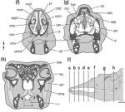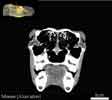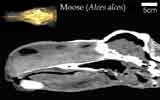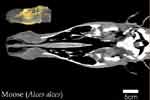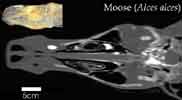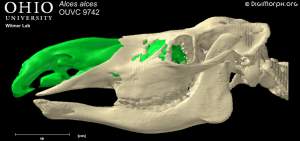Literature
Boas, J. E. V., and S. Paulli. 1908. The elephant's head: studies in the comparative anatomy of the organs of the head of the Indian elephant and other mammals. Part I. Copenhagen: Folio, Gustav Fisher.
Bubenik, A. B. 1997. Evolution, taxonomy, and morphophysiology. In Ecology and Management of the North American Moose:77-123. Franzmann, Albert W. and Schwartz, Charles C. (Eds.). Washington: Smithsonian Institution Press.
Breda, M. 2001. The holotype of Cervalces gallicus (Azzaroli, 1952) from Sénesè (Haute-Loire, France) with nomenclatural implication and taxonomical-phylogenetic accounts. Riv. Italiana Paleontologia e Stratigrafia 107:439-449.
Churcher, C. S., and J. D. Pinsof. 1988. Variation in the antlers of North American Cervalces (Mammalia: Cervidae): Review of new and previously recorded specimens. Journal of Vertebrate Paleontology 7:373-397.
Clifford, A. B., and L. M. Witmer. 2001. The narial anatomy of hooded seals (Cystophora cristata) with respect to other Carnivora. Annual Meeting of the Society of Integrative and Comparative Biology, Chicago, Illinois. American Zoologist 40:976.
Clifford, A. B., and L. M. Witmer. 2002a. Proboscis evolution in Mammalia: preliminary studies. Annual Meeting of the Society of Integrative and Comparative Biology, Anaheim, California. American Zoologist 41:153.
Clifford, A. B., and L. M. Witmer. 2002b. Not all noses are hoses: an appraisal of proboscis evolution in mammals. Annual Meeting of the Society of Vertebrate Paleontology, Norman, Oklahoma. Journal of Vertebrate Paleontology 22(Suppl. to 3):66A.
Clifford, A. B., and L. M. Witmer. 2003. Nasal structures in moose (Cervidae: Alces). Annual Meeting of the Society of Integrative and Comparative Biology, Toronto, Ontario, Canada. Integrative and Comparative Biology 42:137-138.
Clifford, A. B., and L. M. Witmer. 2004. Case studies in novel narial anatomy: 2. The enigmatic nose of moose (Artiodactyla: Cervidae: Alces alces). Journal of Zoology, London 262:339-360.
Clifford, A. B., and L. M. Witmer. in review. Case studies in novel narial anatomy: 3. Structure and function of the nasal cavity of saiga (Artiodactyla: Bovidae: Saiga tatarica). Journal of Zoology, London.
Dawes, J. D. K. 1952. The course of the nasal airstreams. Journal of Laryngology and Otology 66:583-593.
Flerow, K. K. 1952. Genus Alces Gray (1821) - Elk. In Fauna of U.S.S.R.: Mammals. I: Musk Deer and Deer: 166-192.
Franzmann, A. W. 1981. Alces alces. Mammalian Species 154:1-7.
Frey, R., and R. R. Hofmann. 1996. Skull, proboscis musculature and preorbital gland in the saiga antelope and Guenther's dikdik (Mammalia, Bovidae). Zoologischer Anzeiger 235:183-199.
Geist, V. 1999. Moose: behavior, ecology, conservation. Stillwater, MN: Voyageur Press.
Getty, R. 1975. Sisson and Grossman's The Anatomy of the Domestic Animals. I: General, equine, ruminant. (5th edn). Philadelphia: W. B. Sauders Company.
Ghoshal, N. G. 1985. Thermoregulatory role of the cranial circulation in cerebral temperature control. Vlaams Diergeneesk. Tijdschr. 54:246-261.
Groves, C. P., and P. Grubb. 1987. Relationships of living deer. In Biology and Management of the Cervidae: 21-59. Wemmer, Christen M. (Ed.). Washington: Smithsonian Institution Press.
Heptner, V. G., A. A. Nasimovich, and A. G. Bannikow. 1988. Mammals of the Soviet Union. I: Artiodactyla and Perissodactyla. Washington, D. C.: Smithsonian Institution Libraries and the National Science Foundation.
Hofmann, R. R. 1989. Evolutionary steps of ecophysiological adaptation and diversification of ruminants: a comparative view of their digestive system. Oecologia 78:443-457.
Huber, E. 1930. Evolution of facial musculature and cutaneous field of trigeminus, part I. Quarterly Review of Biology 5:133-188.
Jacobi, A. 1921. Die rüsselbildung bei säugertieren der gegenwart und vorzeit. Jena. Z. Naturwiss. 57:199-218.
Johnsen, H. K., and L. P. Folkow. 1988. Vascular control of brain cooling in reindeer. American Journal of Physiology 254:R730-R739.
Karns, P. D. 1997. Population distribution, density, and trends. In Ecology and Management of the North American Moose: 125-140. Franzmann, Albert W. & Schwartz, Charles C. (Eds.). Washington: Smithsonian Institution Press.
Kobal, G., S. Van Toller, and T. Hummel. 1989. Is there directional smelling? Experientia 35:130-132.
Kuhnen, G. 1997. Selective brain cooling reduces respiratory water loss during heat stress. Comp. Biochem. Physiol. 118:891-895.
Langman, V. A., G. M. O. Maloiy, K. Schmidt-Nielson, and R. C. Schroter. 1979. Nasal heat exchange in the giraffe and other large mammals. Respiratory Physiology 37:325-333.
Meinertz, T. 1955. Das facialisgebeit beim Elch (Cervus alces). Morphologische Jahrbuch 96:523-598.
Miquelle, D. G. 1991. Are moose mice? The function of scent urination in moose. American Naturalist 138:460-477.
Moore, W. J. 1981. The Mammalian Skull. New York: Cambridge University Press.
Negus, V. 1958. The Comparative Anatomy and Physiology of the Nose and Paranasal Sinuses. Edinburgh: E. & S. Livinstone, Ltd.
Nickel, R., A. Schummer, E. Seiferle, J. Frewein, H. Wilkens, and K.-H. Wille. 1986. The Anatomy of the Domestic Animals. I: The Locomotor System of the Domestic Mammals. Siller, W. G. & Stokoe, W. M. (trans.). Berlin: Verlag Paul Parey.
Nomina Anatomica Veterinaria. 1994. Ithaca: World Assoc. Vet. Anat.
Novacek, M. J., A. R. Wyss, and M. C. McKenna. 1988. The major groups of eutherian mammals. In The Phylogeny and Classification of the Tetrapods, Volume 2: Mammals: 31-71. Benton, M. J. (ed.) Oxford: Clarendon Press.
Nowak, R. M. 1999. Walker's Mammals of the World. (6th ed.). Baltimore: Johns Hopkins University Press.
Papp, M. J. 2000. A critical appraisal of buccal soft-tissue anatomy in ornithischian dinosaurs. Ohio University Master's Thesis. Ohio University, Athens. 229pp.
Paulli, S. 1900. Über die Pneumaticität des Schädels bei den Säugertieren. Eine morphologische Studie. II. Über die Morphologie des Siebbeins und die der Pneumaticität bei den Ungulaten and Probosciden. Gegenbaurs Morphologische Jahrbuch 28:179-251.
Peterson, R. L. 1978. North American Moose. Toronto: University of Toronto Press.
Schaller, O. 1992. Illustrated veterinary anatomical nomenclature. Stuttgart: Ferdinand Enke Verlag.
Schmidt-Nielsen, K., F. R. Hainsworth, and D. E. Murrish. 1970. Counter-current heat exchange in the respiratory passages: effect on water and heat balance. Respiratory Physiology 9:263-276.
Scott, W. B. 1885. Cervalces americanus, a fossil moose, or elk, from the Quaternary of New Jersey. Proceedings of the Acadamy of Natural Sciences of Philadelphia 37:174-202.
Sedlmayr, J. C., and L. M. Witmer. 2002. Rapid technique for imaging the blood vascular system using stereoangiography. Anatatomical Record 267:330-336.
Sobel, N., R. M. Khan, A. Saltman, E. V. Sullivan, and J. D. E. Gabrieli. 1999. The world smells different to each nostril. Nature 402:35.
Stoddart, D. M. 1979. External nares and olfactory perception. Experentia 35:1456-1457.
Webb, S. D. 2000. Evolutionary history of New World Cervidae. In Antelopes, Deer, and Relatives: 38-64. Vrba, E. S. & Schaller, G. B. (Eds.). New Haven: Yale University Press.
Witmer, L. M. 1995a. The Extant Phylogenetic Bracket and the importance of reconstructing soft tissues in fossils. In Functional Morphology in Vertebrate Paleontology:19-33, Thomason, J. J. (Ed.) New York: Cambridge Univ. Press.
Witmer, L. M. 1995b. Homology of facial structures in extant archosaurs (birds and crocodilians), with special reference to paranasal pneumaticity and nasal conchae. Journal of Morphology 225:269-327.
Witmer, L. M. 2001a. A nose for all reasons. Natural History 110:64-71.
Witmer, L. M. 2001b. Nostril position in dinosaurs and other vertebrates and its significance for nasal function. Science 293:850-853.
Witmer, L. M., S. D. Sampson, and N. Solounias. 1999. The proboscis of tapirs (Mammalia: Perissodactyla): A case study in novel narial anatomy. Journal of Zoology, London 249:249-267.









